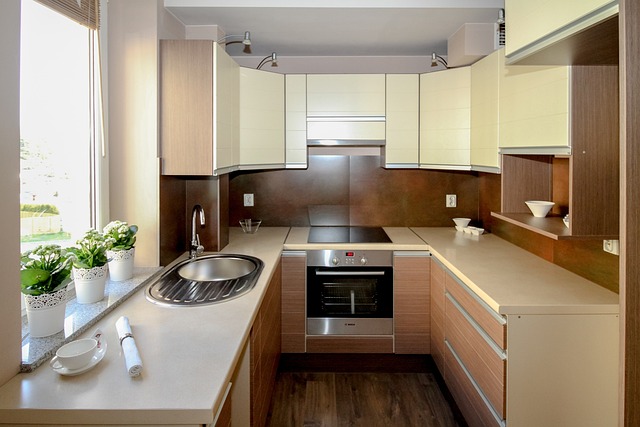This text provides an overview of kitchen flooring options, emphasizing the importance of durability and waterproof properties in high-traffic areas prone to spills. It highlights various materials like tile, hardwood, vinyl, laminate, bamboo, and recycled materials. The guide discusses installation ease, from simple vinyl or laminate to more complex tile and hardwood. Additionally, it offers care instructions for each type, tailored to their specific needs, ensuring longevity and aesthetics. Key SEO keywords include kitchen flooring options, durable kitchen flooring, modern materials, waterproof flooring, tile, hardwood, vinyl, laminate, and eco-friendly choices.
Seamless kitchen flooring installations have become a popular choice for modern homes, offering both style and functionality. This comprehensive guide explores the various aspects of transforming your kitchen space. From understanding unique flooring requirements to selecting from durable options like tile, hardwood, vinyl, or laminate, we cover it all. Learn about installation considerations, including waterproof materials ideal for kitchens, and discover maintenance tips to ensure your new floor lasts. Discover the perfect blend of aesthetics and longevity for your culinary haven.
- Understanding Kitchen Flooring Requirements
- Exploring Popular Kitchen Flooring Options
- Installation Considerations for Seamless Floors
- Tips for Maintaining a Long-Lasting Kitchen Floor
Understanding Kitchen Flooring Requirements
When it comes to kitchen flooring, understanding your requirements is half the battle won. Kitchens are high-traffic areas, prone to spills and stains, and often subjected to moisture from sinks and appliances. Therefore, durable kitchen flooring options are a must. Waterproof kitchen flooring is particularly desirable to prevent water damage and make cleaning easier. Tile flooring for kitchens offers both style and functionality, with various materials available that can suit any design aesthetic, from classic ceramic tiles to modern porcelain options.
Hardwood kitchen floors have long been a popular choice for their natural beauty and warmth, but they require careful maintenance to withstand the wear and tear of daily use. Vinyl kitchen flooring is another versatile option known for its ease of installation and low cost, making it ideal for those looking for an affordable yet durable solution. Laminate kitchen flooring has also gained popularity due to its resemblance to hardwood and water resistance. For eco-conscious homeowners, there are plenty of green options available, such as bamboo or recycled materials, that provide both style and sustainability without compromising on quality.
Exploring Popular Kitchen Flooring Options
When it comes to transforming your kitchen, choosing the right flooring is a significant decision. There are numerous kitchen flooring options available, each with its unique aesthetics and practical benefits. From classic hardwood floors that exude warmth and charm to modern tile designs that offer both style and functionality, the possibilities are endless.
Waterproof kitchen flooring is gaining popularity due to its durability and ease of maintenance. Vinyl and laminate floors are excellent choices for busy kitchens, as they are resistant to scratches, stains, and water damage. For an eco-friendly approach, consider natural materials like bamboo or cork, which provide a sustainable alternative to traditional hardwoods without compromising on aesthetics or comfort underfoot.
Installation Considerations for Seamless Floors
When considering seamless kitchen floor installations, several installation factors come into play to ensure a successful outcome. First and foremost, determining the most suitable kitchen flooring options is essential. Among popular choices, durable kitchen flooring like vinyl and laminate offer water resistance, making them ideal for wet environments. Modern kitchen floor materials such as tile and hardwood floors are also common selections that blend aesthetics with functionality.
The complexity of the installation process varies based on the chosen material. For example, waterproof kitchen flooring like vinyl or laminate is generally easier to install compared to tile flooring for kitchens or hardwood kitchen floors, which demand more intricate laying and sealing techniques. Furthermore, selecting eco-friendly kitchen floors made from sustainable materials aligns with contemporary trends while contributing to environmental preservation.
Tips for Maintaining a Long-Lasting Kitchen Floor
To ensure your kitchen floor remains in top condition and lasts for years to come, consider these maintenance tips tailored to various kitchen flooring options. For tile flooring for kitchens, regular cleaning with a mild detergent and a damp mop is sufficient. Avoid harsh chemicals that can damage the finish. Hardwood kitchen floors need more care; sweep or vacuum daily to prevent debris buildup, and use a wood-specific cleaner periodically. Avoid placing hot objects directly on the wood to prevent burning or warping.
When it comes to durable kitchen flooring, waterproof kitchen flooring like vinyl or laminate is ideal for high-moisture areas. These materials are easy to maintain; simply wipe up spills promptly and use a floor mat to reduce water damage. For modern kitchen floor materials that exude style, such as vinyl or laminate, a quick sweep or vacuum is usually enough. Natural hardwood or eco-friendly kitchen floors require more attention, including seasonal conditioning with a food-safe oil to maintain their luster and protect against moisture.
When it comes to transforming your kitchen, choosing the right flooring is a significant decision. By understanding your requirements and exploring diverse options like tile, hardwood, vinyl, or laminate, you can find a durable, modern, and aesthetically pleasing solution. Installation considerations and regular maintenance will ensure your new kitchen floor stands the test of time, providing both functionality and style for years to come. Embrace an eco-friendly approach with waterproof materials for added peace of mind in this high-moisture environment.
